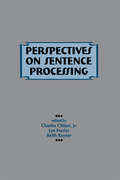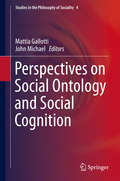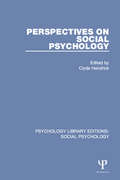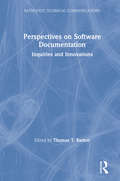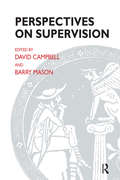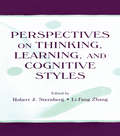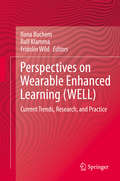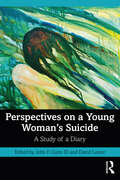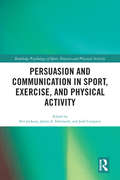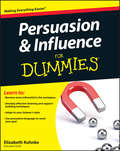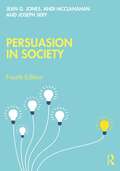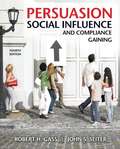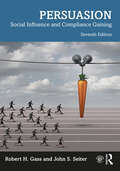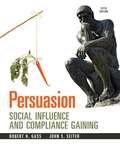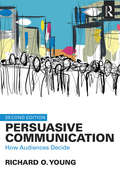- Table View
- List View
Perspectives on Sentence Processing
by Keith Rayner Charles Clifton Lyn FrazierOne of the liveliest forums for sharing psychological, linguistic, philosophical, and computer science perspectives on psycholinguistics has been the annual meeting of the CUNY Sentence Processing Conference. Documenting the state of the art in several important approaches to sentence processing, this volume consists of selected papers that had been presented at the Sixth CUNY Conference. The editors not only present the main themes that ran through the conference but also honor the breadth of the presentations from disciplines including linguistics, experimental psychology, and computer science. The variety of sentence processing topics examined includes: * how evoked brain potentials reflect sentence comprehension * how auditory words are processed * how various sources of grammatical and nongrammatical information are coordinated and used * how sentence processing and language acquisition might be related. This distinctive volume not only presents the most exciting current work in sentence processing, but also places this research into the broader context of theorizing about it.
Perspectives on Social Ontology and Social Cognition
by John Michael Mattia GallottiPerspectives on Social Ontology and Social Cognition brings together contributions discussing issues arising from theoretical and empirical research on social ontology and social cognition. It is the first comprehensive interdisciplinary collection in this rapidly expanding area. The contributors draw upon their diverse backgrounds in philosophy, cognitive science, behavioral economics, sociology of science and anthropology. Based largely on contributions to the first Aarhus-Paris conference held at the University of Aarhus in June 2012, the book addresses such questions as: If the reference of concepts like money is fixed by collective acceptance, does it depend on mechanisms that are distinct from those which contribute to understanding the reference of concepts of other kinds of entity? What psychological and neural mechanisms, if any, are involved in the constitution, persistence and recognition of social facts? The editors' introduction considers strands of research that have gained increasing importance in explaining the cognitive foundations of acts of sociality, for example, the theory that humans are predisposed and motivated to engage in joint action with con-specifics thanks to mechanisms that enable them to share others' mental states. The book also presents a commentary written by John Searle for this volume and an interview in which the editors invite Searle to respond to the various questions raised in the introduction and by the other contributors.
Perspectives on Social Psychology (Psychology Library Editions: Social Psychology)
by Clyde HendrickOriginally published in 1977, this volume was intended to provide a relatively elementary and clear overview of some of the more important approaches to social psychology at the time. There are a number of perspectives on this discipline, but here, instead of traditional theoretical approaches (e.g. field theory, role theory or S-R) the point of view is from the general perspective. The first chapter approaches social psychology as an experimental science, with the history and philosophic traditions discussed, as well as the current state of the field. Other chapters approach the discipline from the perspectives of symbolic interaction, social development, and ethology. The final chapter is devoted to the uses of mathematical models in social psychology. <P><P> This volume was intended to serve as a helpful integration of the field, and will still be useful as a text in its historical context.
Perspectives on Social Psychology: A Psychology of Human Being
by Wendy Stainton RogersThis groundbreaking new textbook takes a different perspective on social psychology, focused on the social and cultural worlds we inhabit, and encompassing a wide range of core social psychology topics – from the self to relationships, gender to health, racism to mental distress. Taking a critical approach, this book explores how qualitative methods and interpretational analyses can be used to examine human behaviour and what it is like living in today’s media-led world. It explicitly challenges all forms of Othering, taking a fresh look at human values, embodiment, agency, communication, thinking and feeling. It goes beyond the individualising scientific approach taken by traditional psychology, instead concentrating on the psychology of what makes us human – qualities like empathy and compassion, courage and dignity, kindness and sympathy – and how we can nurture them. Offering a fascinating alternative to existing resources and enhanced by carefully chosen full-colour illustrations, the book and associated companion website include original pedagogical features such as reflective exercises, further resources and a glossary, offering opportunities for readers to customise their learning experience. Featuring a course mapping section that sets out how the text can be used in relation to psychology curriculum requirements and common course structures, this interdisciplinary resource provides accessible and engaging reading for students studying psychology and other disciplines, including sociology, cultural studies, politics and media studies, as well as applied areas such as nursing, policing and management. It is also for anyone who is interested in what psychology can tell us about our lives and place in the world.
Perspectives on Software Documentation: Inquiries and Innovations (Baywood's Technical Communications)
by Thomas T BarkerThis book is designed to address the randomness of the literature on software documentation. As anyone interested in software documentation is aware, the field is highly synthetic; information about software documentation may be found in engineering, computer science training, technical communication, management, education and so on. "Perspectives on Software Documentation" contains a variety of perspectives, all tied together by the shared need to make software products more usable.
Perspectives on Supervision (The Systemic Thinking and Practice Series)
by David Campbell Gill Gorell Barnes Barry MasonThis reader-friendly and stimulating volume, indispensable to anyone interested in supervision from a systemic perspective, emerged from a conference organised jointly by the Institute of Family Therapy and the Tavistock Clinic in London. It is focused on developments within supervisions and reflects the increasing need for clinical supervisors in advanced level family training courses. The central theme of the book is the application of systemic thinking to the field of supervision. The complexities of topics involved in this area are fully engaged by the many contributors. The book is organised into four main sections, each ending with a useful and unifying commentary from the editors.
Perspectives on Thinking, Learning, and Cognitive Styles (Educational Psychology Series)
by Robert Sternberg Li-Fang ZhangThis volume presents the most comprehensive, balanced, and up-to-date coverage of theory and research on cognitive, thinking, and learning styles, in a way that: * represents diverse theoretical perspectives; * includes solid empirical evidence testing the validity of these perspectives; and * shows the application of these perspectives to school situations, as well as situations involving other kinds of organizations. International representation is emphasized, with chapters from almost every major leader in the field of styles. Each chapter author has contributed serious theory and/or published empirical data--work that is primarily commercial or that implements the theories of others. The book's central premise is that cognitive, learning, and thinking styles are not abilities but rather preferences in the use of abilities. Traditionally, many psychologists and educators have believed that people's successes and failures are attributable mainly to individual differences in abilities. However, for the past few decades research on the roles of thinking, learning, and cognitive styles in performance within both academic and nonacademic settings has indicated that they account for individual differences in performance that go well beyond abilities. New theories better differentiate styles from abilities and make more contact with other psychological literatures; recent research, in many cases, is more careful and conclusive than are some of the older studies. Cognitive, learning, and thinking styles are of interest to educators because they predict academic performance in ways that go beyond abilities, and because taking styles into account can help teachers to improve both instruction and assessment and to show sensitivity to cultural and individual diversity among learners. They are also of interest in business, where instruments to assess styles are valuable in selecting and placing personnel. The state-of-the-art research and theory in this volume will be of particular interest to scholars and graduate students in cognitive and educational psychology, managers, and others concerned with intellectual styles as applied in educational, industrial, and corporate settings.
Perspectives on Transitions in Schooling and Instructional Practice
by Susan E. Elliott-Johns Daniel H. JarvisPerspectives on Transitions in Schooling and Instructional Practice examines student transitions between major levels of schooling, teacher transitions in instructional practice, and the intersection of these two significant themes in education research. Twenty-six leading international experts offer meaningful insights on current pedagogical practices, obstacles to effective transitions, and proven strategies for stakeholders involved in supporting students in transition.The book is divided into four sections, representing the four main transitions in formal schooling: Early Years (Home, Pre-school, and Kindergarten) to Early Elementary (Grades 1-3); Early Elementary to Late Elementary (Grades 4-8); Late Elementary to Secondary (Grades 9-12); and Secondary to Post-Secondary (College and University). A coda draws together over-arching themes from throughout the text to provide recommendations and a visual model that captures their interactions.Combining theoretical approaches with practical examples of school-based initiatives, this book will appeal to those involved in supporting either the student experience (both academically and emotionally) or teacher professional learning and growth.
Perspectives on Violence and Violent Death (Death, Value and Meaning Series)
by Robert G Stevenson Gerry R CoxThis book examines violence. It looks at the nature and types of violence, the causes of violence, and the emotional wake left by violent episodes. In the twentieth century, the world experienced two world wars and countless other wars. Many millions died violent deaths from murder, death squads, purges, riots, revolutions, ethnic cleansing, rape, robbery, domestic violence, suicide, gang violence, terrorist acts, genocide, and in many other ways. As we entered the twenty-first century, we experienced 9/11, the Red Lake School deaths, suicide bombers, and more mass death brought about by the actions of governments, revolutionaries, terrorists, and still more wars. The need to better understand violence, both lethal and non-lethal, to become aware of the many forms of violence, and to learn how to survive in the aftermath of violent death are the focus of "Perspectives on Violence and Violent Death."
Perspectives on Wearable Enhanced Learning (WELL): Current Trends, Research, and Practice
by Fridolin Wild Ralf Klamma Ilona BuchemWearable technologies – such as smart glasses, smart watches, smart objects, or smart garments – are potential game-changers, breaking ground and offering new opportunities for learning. These devices are body-worn, equipped with sensors, and integrate ergonomically into everyday activities. With wearable technologies forging new human-computer relations, it is essential to look beyond the current perspective of how technologies may be used to enhance learning. This edited volume,“Perspectives on Wearable Enhanced Learning,” aims to take a multidisciplinary view on wearable enhanced learning and provide a comprehensive overview of current trends, research, and practice in diverse learning contexts including school and work-based learning, higher education, professional development, vocational training, health and healthy aging programs, smart and open learning, and work. This volume features current state of the art wearable enhanced learning and explores how these technologies have begun to mark the transition from the desktop through the mobile to the age of wearable, ubiquitous technology-enhanced learning.
Perspectives on a Young Woman's Suicide: A Study of a Diary
by David Lester John F. GunnPerspectives on a Young Woman's Suicide is a unique and updated analysis of a diary left behind by "Katie," a young woman who took her own life. By drawing on clinicians, researchers, survivors of suicide loss, and those closest to Katie, this book delves into common beliefs about why people die by suicide and into the internal worlds of those who do, as well as ethical and moral questions surrounding those deaths. Several contributors discuss Katie’s suicide from the perspective of recent theories of suicide, including Joiner’s interpersonal theory and Klonsky’s three-step theory. Two contributors who have lost a child to suicide look at Katie’s diary from their perspective, one of whom discusses whether it is truly possible to prevent suicide. Finally, Katie’s sister reveals her reactions to this project and her ex-boyfriend shares his account of her death. This book is a vital addition to the library of any researcher, academic, or professional interested in suicide and suicide prevention.
Perspectives on the Architecture and Acquisition of Syntax: Essays In Honour Of R. Amritavalli
by Gautam Sengupta Shruti Sircar Madhavi Gayathri Raman Rahul BalusuThis festschrift volume brings together important contributions by expert syntacticians across the globe on tense and finiteness, adjectives, dative and ergative case, acquisition of case, and other topics both within the domain of Dravidian linguistics and in the broader theoretical understanding of cross-linguistic data. Professor R. Amritavalli, a renowned linguist, has spent over three decades in the fields of syntax and syntactic acquisition, making important and landmark contributions in these areas, and this book is a recognition of her work. The contributors cover these themes in the context of English, Chinese, Japanese, Korean, Hindi-Urdu, Bangla, Dravidian languages, and understudied languages like Huave. The analyses presented here have major implications for current theories of syntax and semantics, first and second language acquisition, language typology and historical linguistics, and will be a valuable resource for students, researchers and teachers.
Perspectives on the Intersection of Multiculturalism and Positive Psychology
by Lisa M. Edwards Jennifer Teramoto PedrottiThe volume will be a collection of chapters about current theory, research, and practice related to multiculturalism and positive psychology. This book will serve as a reference to any who are interested in the intersection of positive psychology and multicultural context. While many in the field of positive psychology have begun to move more strongly towards a culturally-embedded approach that recognizes the importance of context in discussing, viewing and cultivating strengths in individuals from different backgrounds, there is still a dearth of research in this area compared with studies that take a cross-cultural approach (comparing people from different countries) or one that is purported to be "culture-free" or universal in its application. While it is becoming more common to see various articles or chapters published on these topics, there is still no comprehensive text aimed at discussion of the collection of these topics presented in a cohesive and structured way. This book aims to fill this gap in the literature. In this book, a broad definition of culture is utilized that includes such facets as race, ethnicity, socioeconomic or social class status, disability, religion, sexual orientation and gender. This book is intended to present research, theory and suggestions for practice that are grounded in diverse cultural contexts and current scholarship. It will assist researchers, students and practitioners who are studying and working within diverse populations. Currently there exists no comprehensive text that addresses the intersection of positive psychology and multiculturalism. Several edited volumes address positive psychology constructs (e. g. , well-being, optimal experience, autonomy) across cultures, but they do not focus on multicultural populations within the United States. Other books focus more specifically on mental health applications and stress and coping among multicultural populations, however these books do not provide a broad perspective on psychology beyond this application piece. The proposed book will review current theory and research about constructs in addition to applications across contexts. Finally, other published books have focused on youth within multicultural society; this volume is more broad in its address of issues of positive psychology across the lifespan and across various aspects of identity including disability, gender, social class and sexual orientation.
Perspectives on the Study of Speech
by Peter D. Eimas, Joanne L. MillerPublished in the year 1982, Perspectives on the Study of Speech is a valuable contribution to the field of Cognitive Psychology.
Persuasion and Communication in Sport, Exercise, and Physical Activity (Routledge Psychology of Sport, Exercise and Physical Activity)
by Edited by Ben Jackson, James A. Dimmock, and Josh ComptonHow can we use persuasion methods to make people more physically active and improve their sport and exercise experiences? How can instructors, coaches, athletes, and practitioners most effectively communicate their messages to others? Persuasion and Communication in Sport, Exercise, and Physical Activity is the first book to consider the applications of persuasion frameworks within activity-related contexts, while also summarizing the major developments relating to communication topics in these settings. It provides a state of the art review of the key developments, challenges, and opportunities within the field. It brings together international experts from the fields of social, health, and sport and exercise psychology, to give theoretical overviews, insights into contemporary research themes and practical implications, as well as agendas for future research. Covering topics such as changing attitudes towards exercise, social influence, persuasive leadership and communicating with people with physical disabilities, this book provides a contemporary approach to persuasion and communication in a sport, exercise and physical activity setting. It is an important text for upper-level undergraduate and postgraduate students, as well as academics in the fields of Sport and Exercise Science, Kinesiology, Health and Physical Activity Promotion, and related areas of Psychology.
Persuasion and Healing: A Comparative Study of Psychotherapy
by Jerome D. Frank Julia B. FrankThis popular study of "psychological healing"treats topics ranging from religious revivalism and magical healing to contemporary psychotherapies, from the role of the shaman in nonindustrialized societies to the traditional mental hospital. Jerome and Julia Frank (who are father and daughter) contend that these therapies share common elements that improve the "morale"of sufferers. And in combating the "demoralizing meaning"that people attach to their experiences, the authors argue, many therapies are surprisingly similar to rhetoric (the art of persuasion) and to hermeneutics (the study of meanings).Highly acclaimed in previous editions, Persuasion and Healing has been completely revised and expanded. In addition to a broadened exploration of the role of demoralization in illness, this latest edition offers updated information on topics including self-help, family therapy, psychopharmacology, psychotherapy for the mentally ill, and techniques such as primal therapy and bioenergetics. As they explore the power of "healing rhetoric"in these activities, the authors strengthen the ties among the various healing profession.
Persuasion and Influence For Dummies
by Elizabeth KuhnkeMany people want to gain trust or support in business and throughout life, but the true skill is doing so in a charming fashion! Whether you're convincing the boss about your much-deserved promotion or a busy restaurateur to offer a better table, the power of persuasion can help improve and increase your successes.Elizabeth Kuhnke, author of the bestselling Body Language For Dummies, guides the reader through easy-to-implement techniques that can turn a timid person into someone bursting with self confidence and the ability to influence.Topics covered will include:The key elements in becoming more persuasive - body language, listening skills, using persuasive words and actions Finding a common ground and establishing a connection with your audience Capturing their attention and keeping them interested Putting yourself across convincingly Getting things done through others Identifying the type of person you're dealing with - and responding in an appropriate manner
Persuasion in Society
by Jean G. Jones Andi McClanahan Joseph SeryThis fully-updated fourth edition introduces readers to the rich tapestry of persuasive technique and scholarship, interweaving perspectives from rhetoric, critical theory, and social science and applying their insights to practical political, social, and business contexts. This text examines current and classical theory through the lens of contemporary culture, encouraging readers to explore the nature of persuasion and to understand its impact in their lives. Employing a contemporary approach, it draws from popular culture, mass media, social media, advertising, political campaigns, and social movements to help readers become informed creators and consumers of persuasive messages. Case studies show how and why people fall for persuasive messages, demonstrating how persuasion works at a cognitive level. This new edition includes extended treatment of the ethics of persuasion, including opposing views on handling controversial issues in the college classroom; a new chapter on propaganda and ideology; and a greater focus on digital contexts and social media. Discussion questions, exercises, and key terms are provided for each chapter. This textbook will be a valuable tool for students of communication, media studies, politics, psychology, and business and advertising. Online resources for instructors include PowerPoint slides and test bank.
Persuasion, Social Influence, and Compliance Gaining (4th edition)
by Robert H. Gass John S. SeiterThis text looks at persuasion from a broad-based perspective, encompassing the scope of persuasion found in everyday life. By examining persuasion in contexts such as advertising, small groups, and face-to-face encounters, the text places emphasis on new avenues of studying persuasion, such as deception and deception detection, compliance gaining, and music as persuasion. This second edition contains a new chapter on visual persuasion, expanded discussions of propaganda and cultural influences on persuasion, and a new section on adapting to audiences. Gass is affiliated with California State University. Seiter is affiliated with Utah State University. Annotation c. Book News, Inc. , Portland, OR (booknews. com)
Persuasion: Social Influence and Compliance Gaining
by John S Seiter Robert H GassThe seventh edition of this field-leading textbook provides an accessible and rigorous presentation of major theories of persuasion and their applications to a variety of real-world contexts. In addition to presenting established theories and models, this text encourages students to develop and apply general conclusions about persuasion in real-world settings. Along the way, students are introduced to the practice of social influence in an array of contexts (e.g., advertising, marketing, politics, interpersonal relationships, social media, groups) and across a variety of topics (e.g., credibility, personality, deception, motivational appeals, visual persuasion). The new edition features expanded treatment of digital and social media; up-to-date research on theory and practice; an increased number of international cases; and new and expanded discussions of topics such as online influencers, disinformation and 'fake news,' deepfakes, message framing, normative influence, stigmatized language, and inoculation theory. This is the ideal textbook for courses on persuasion in communication, psychology, advertising, and marketing programs. Instructors can also use the book’s downloadable test bank, instructor’s manual, and PowerPoint slides in preparing course material.
Persuasion: Social Influence and Compliance Gaining
by Robert H. Gass John S. SeiterThe 5th edition explores how social media continues to be a form of influence, but it also looks at grassroots movements, such as the Tea Party and Occupy Wall Street, and traditional forms of persuasion, such as advertising, marketing, and political campaigning.
Persuasive Communication, Third Edition
by Paul A. Mongeau James B. StiffProviding an accessible integration of theory and research methods, this text prepares students to critically analyze persuasive appeals and to design effective messages and campaigns. The book draws on key ideas from both communication and social psychology to explore the mutual influence of cognitive and affective processes and the characteristics and production of messages. It gives the reader a solid grasp of foundational issues in persuasion research, the core components of persuasive transactions, and major theoretical models. Instructive concrete examples illustrate applications of the concepts in such settings as health promotion, political campaigns, the courtroom, and advertising. New to This Edition *Engaging topic boxes on college drinking, attitudes about same-sex marriage, the "birther" movement, and other timely issues. *New or expanded discussions of the integrative model of behavioral prediction, the use of guilt appeals, social media, individualized tailoring of political messages, and numerous other topics. *The latest data and theoretical perspectives. *Epilogue on current and future trends in the field.
Persuasive Communication: How Audiences Decide
by Richard O. YoungThis updated and expanded edition of Persuasive Communication offers a comprehensive introduction to persuasion and real-world decision making. Drawing on empirical research from social psychology, neuroscience, business communication research, cognitive science, and behavioral economics, Young reveals the thought processes of many different audiences—from investors to CEOs—to help students better understand why audiences make the decisions they make and how to influence them. The book covers a broad range of communication techniques, richly illustrated with compelling examples, including resumes, speeches, and slide presentations, to help students recognize persuasive methods that do, and do not, work. A detailed analysis of the emotions and biases that go into decision making arms students with perceptive insights into human behavior and helps them apply this understanding with various decision-making aids. Students will learn how to impact potential employers, clients, and other audiences essential to their success. This book will prove fascinating to many, and especially useful for students of persuasion, rhetoric, and business communication.
Persuasive Copywriting
by Andy Maslen"We ordered coffee, cut open a human brain and discovered the secret of persuasive copywriting." A chance encounter with a neuroscientist showed Andy Maslen that his belief in the power of emotion was founded on hard science. Over coffee, the two discussed brain anatomy and the reason-defying power of human emotions.Andy's subsequent research led him to realise that how people think and feel haven't changed since the time of cavemen. We make decisions on emotional grounds and rationalise them later.Persuasive Copywriting takes you deep inside customers' brains. You'll learn the relationship between selling and storytelling. And the market-tested techniques that get people to engage with, and be persuaded by, your copy. Use it to modify people's behaviour by tapping into their deepest psychological drives. Gain copywriting confidenceThis course-in-a-book explains the neuroscience behind our appetite for stories. It demystifies advanced copywriting skills with examples, exercises and tips. And it helps you hone your skills with easy-to-use tools included in the book, and online... 13 real-world case studies 25 psychological copywriting techniques 75 practical exercises 125 words and phrases that trigger emotions 125-question copywriting quizAll help you improve your copywriting skills and perfect the emotion-driven sale.Who should buy Persuasive Copywriting? Junior copywriters can use it to catch up with their more experienced peers. Senior copywriters can use it to stay ahead of the game. Now you can employ this powerful psychological approach.This enjoyable book helps you find the right tone of voice, avoid common copywriting traps and tap into customers' deepest drives. You'll find yourself writing enjoyable, compelling copy that stands out in today's cluttered marketplace.Andy has achieved amazing results for his clients by focusing on stories and their deep connection to customers' needs and wants. With this book by your side, you can too.
Persuasive Copywriting: Cut Through the Noise and Communicate With Impact
by Andy MaslenPersuasive Copywriting, second edition, is the ultimate copywriting survival guide for the 21st century. With the majority of creative professionals developing their skills on the job, it is notoriously difficult to benchmark successful copy. This book provides a step up for those who already know the basics, and are seeking more advanced, psychology-driven techniques to gain the competitive edge. With practical insight into human decision making and consumer engagement, it inspires the clear-cut confidence needed to create, quantify and sell stand out copy in a cluttered marketplace. This second edition of Persuasive Copywriting complements the "how to" perspective of copywriting, with impressive interviews from leading ad agencies and copywriters across the globe, addressing day to day issues faced in a multitude of roles. Updates include practical advice to measure and benchmark effective copy, guidance on creating and critiquing briefs, plus four new chapters on how to weave copywriting skills into the wider industry. These cover particularly useful ground around storytelling, content marketing and the impact of evolving channels like mobile and social media. Practical and inspiring, it is a vibrant, all-encompassing guide to copywriting; an essential to every marketer's bookshelf.
